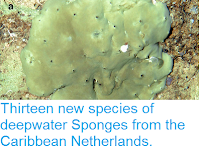The seafloors of the abyssal plains form one of the largest habitats on Earth, covering vast areas of the ocean floor at depths of between 3000 and 6000 m. This environment is fairly uniform, with permanent darkness, temperatures of less than 4° C, very high pressures and limited nutrients. This environment is home to a sparse, but diverse fauna, though this fauna is, due to its location, poorly understood by scientists.
In a paper published in the journal Systematics and Biodiversity on 24 September 2017, Swee-Cheng Lim of the Keppel-NUS Corporate Laboratory at the National University of Singapore, Helena Wiklund and Adrian Glover of the Life Sciences Department at The Natural History Museum, Thomas Dalgreen of Uni Research and the Gothenburg Global Biodiversity Centre at the University of Gothenburg, and Koh-Siang Tan, also of the Keppel-NUS Corporate Laboratory at the National University of Singapore, describe a new species of encrusting Heteroscleromorph Demosponge from polymetallic nodules in the Clarion-Clipperton Zone of the East Pacific Ocean.
Polymetallic nodules are widespread on the abyssal plains; they are concretions formed by the accumulation of iron and manganese hydroxides around a core, and also contain copper, nickel, cobalt, zinc, silver, and numerous other metals. This has made them of great interest to mineral exploration companies for many years, with a variety of plans to harvest the nodules having been brought foreword, though as yet the problem to how to raise the nodules from the seafloor without expending more energy than the value of the metals justifies has yet to be solved.
The Clarion-Clipperton Zone lies between the Clarion and Clipperton Fracture Zones in the East Pacific, and has been designated by the International Seabed Authority as a site for experimental, and potentially eventually commercial, nodule exploitation.
Sponges (Porifera) are considered to be the most primitive form of
animals. They lack differentiated cells, and can reform if disassociated
by (for example) shoving them through a sieve. On the other hand they
cannot be considered colonies of single-celled organisms, as they have
definite structures, bodies with more-or-less set shapes consisting of
networks of pores and channels through which water is pumped; the
individual cells feeding separately by filtering food from the water in
these channels. They are the only extant group of animals with a fossil
record that extends significantly into the Precambrian. Demosponges are the largest class of living Sponges, distinguished by the presence of a skeleton made up of spicules of the protein spongin. Members of the subclass Heteroscleromorpha are further distinguished by the additional presence of silica spicules.
The new species is named Plenaster craigi, where 'Plenaster' means 'plenty of stars' in reference to the numerous star-shaped skeletal elements of the species, and 'craigi' honours Craig Smith of the University of Hawaii, who was the chief scientist on the expedition that recovered the specimens from which the species is described. The species is named from forty two specimens, collected from depths of between 4041 and 4183 m. The Sponges are white in colour, and form encrustations on the nodules 1-2 mm thick and at most 10 mm in diameter.
Plenaster craigi has a simple skeleton, with only two different skeletal elements, with numerous star-shaped elements (spheroxyasters) and a smaller number of pointed elements (styles) which protrude through the surface of the Sponge.
See also...
The new species is named Plenaster craigi, where 'Plenaster' means 'plenty of stars' in reference to the numerous star-shaped skeletal elements of the species, and 'craigi' honours Craig Smith of the University of Hawaii, who was the chief scientist on the expedition that recovered the specimens from which the species is described. The species is named from forty two specimens, collected from depths of between 4041 and 4183 m. The Sponges are white in colour, and form encrustations on the nodules 1-2 mm thick and at most 10 mm in diameter.
Specimen of Plenaster craigi after it was retrieved from a box core sample at sampling site S04 in Ocean Mineral Singapore exploration area, Clarion-Clipperton Zone (East Pacific Ocean). The hispid surface of the sponge is due to the protruding styles. Scale bar is 1 mm. Lim et al. (2017).
Plenaster craigi has a simple skeleton, with only two different skeletal elements, with numerous star-shaped elements (spheroxyasters) and a smaller number of pointed elements (styles) which protrude through the surface of the Sponge.
Spheroxyasters from Plenaster craigi. Scale bar is 5 mm. Lim et al. (2017).
Styles in Plenaster craigi. Scale bar is 10 mm. Lim et al. (2017).
See also...
Follow
Sciency Thoughts on Facebook.









